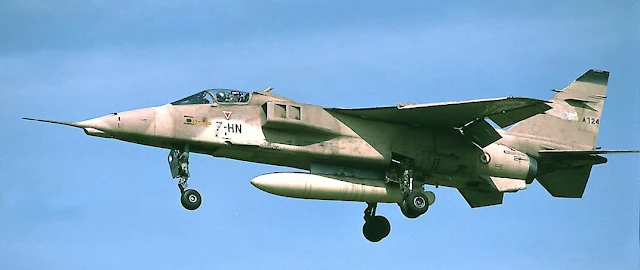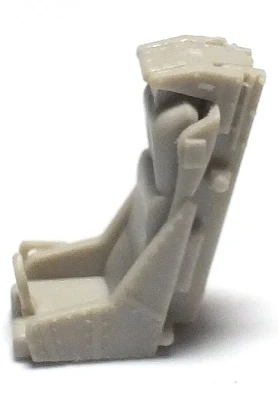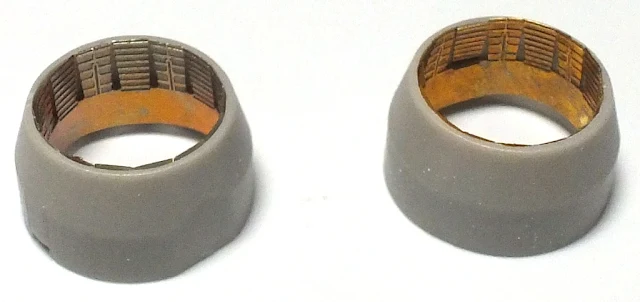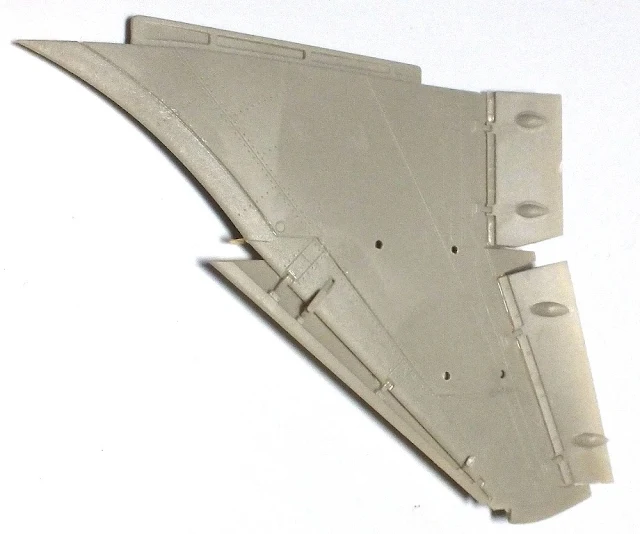Our man Eth continues on with his excellent builds –
today is the first in the two part special on the new Sepecat Jaguar in 48th
scale from KittyHawk – we thought we
would get him warmed up with the French Jaguar A before he takes on the RAF Jag
– more on that later – but today enjoy the view…
KittyHawk 1/48th
Jaguar A
How
long has it been since we had a new tool kit of the Jaguar, a jet that was
built as collaboration between the UK and France? For years modellers had to
make do with the Heller and Esci kits, or the ancient and hard to find Airfix
kit. Well now that wait is over and I for one am extremely glad to see this
beautiful aircraft now have a kit to do it justice. If you wish to learn more
about the actual aircraft here are a couple of links that you should find
useful
The Kit
Upon opening the box you are met with a full box indeed, there seems to be more sprues than seem necessary to build a 1/48th scale Jaguar. However this is all due to KittyHawk packing in as much detail as is possible. It appears that KittyHawk want to produce more versions of the Jaguar, this is evident from the main fuselage being supplied in four pieces. This also allows the modeller to build the bulk of the model without having to first build and paint the cockpit, I wish other manufacturers would take this approach.
So let’s take a look at the cockpit and see what we
get. Firstly there are two different ejection seats Included, a Martin Baker Mk
4 and Mk9, so check your references before installing.
Whichever Seat you choose will benefit from a set of
PE seat belts and these are included on the PE fret, nice one! The rest of the
cockpit is one of the best I have seen in plastic and with the addition of the Photo
etched (PE) parts it should look outstanding with some careful painting. The
front wheel bay looks suitably busy and will look more than adequate as is,
although there is also room for the super-detailers to apply their art.
Something that surprised me was the inclusion of the port
side avionics bay. This is something that will appeal to modellers who like to
leave panels open to display the internals. The same can be said of the
engines/exhausts. These can be displayed in situ with the appropriate panels
left off, again a nice feature and one that other manufacturers can learn
from.
The main undercarriage bays have the same level of
detail as the front bay, although I do have a minor gripe here and that is to
do with the tyres. There is nothing wrong with them except they are round with
no flat spots. Considering the level of detail in other areas of this kit I
expected there to be flat spots on the bottom of the tyres. Not a major problem
to overcome but one that it would have been nice to see weighted tyres. The
undercarriage does have that “meaty” look to it that was evident on the real
Jaguar.
Looking at the engines there is an impressive amount
of detail both in plastic and PE and it is doubtful that resin manufacturers
could do better, which is praise indeed from me. The PE for the exhaust might
be problematic to form but from past experience annealing will make this
process much easier and I cannot wait to see these built up. The detail around
the exhaust looks impressive with some restrained, but accurate, riveting.
Hopefully the fit of these parts will live up to the detail as trying to clean
up any putty will be a nightmare.
When it comes to the wings there is the opportunity
to deploy the flaps, slats and spoilers, it is not that long ago when the only
way to achieve this was to cut the appropriate parts from the main wings, so
another point in KittyHawk’s favour.
The weapons
supplied cover virtually every eventuality although I would suggest you check
your references to ensure the correct weapons load out. Weapons and pods
supplied with the kit include the following:
BGL 1000
250kg Bombs
AS.37
BGL 400
AS.30
BGL 66
PHIMAT
Matra 155
OBL 755
Aim-9L
ATLIS
Magic 2
Barracuda
So as can be seen there are enough weapons and
electronic pods to start your own war. This isanother plus as other manufacturers would have you
buy an additional weapons set. The clearplastic parts are up to the expected standard and do
not have seam lines running through them, so no need for clean up, a definite plus as far as I am
concerned.
The kit contains two sets of decals and look to be in
perfect register. One set of decals is for abrown/sand scheme as sported by No 124, EC01/007,
Province Saint-Dizier, 1994. The second set ofdecals are for a Dark Green/Dark Grey Jaguar No 62.
“Boars Head”. The painting instructions are infull colour.
Conclusion
The more I have looked through the box and the
sprues, the more I am impressed by the quality of the parts provided. On detail alone I would suggest
that the KittyHawk Jaguar rivals releases from more established manufacturers
and this really does bode well for our hobby. That a new(ish) manufacturer can
produce a kit of this quality really is good news for modellers. However this can
all change when the model is built which I hope to start in the next few weeks.
The Build:
In the early 1960s, Britain and France began a
collaboration to build a new trainer / strike aircraft. After some
difficulties, this machine finally emerged as the SEPECAT "Jaguar",
which has provided excellent service for decades in the air forces of Britain,
France, and several other nations.
The kit markings from the actual aircraft I will make..
Over its career the jaguar underwent many changes to
keep it up to date with the latest equipment, including mounting missile rails
on the top of the main wings, something that had not been seen before. The
first French Jaguar E two seat trainer flew on the 8th of September
1968 with the first single seat French jaguar flight being on the 23 March
1969. It is the French version that is the subject matter of this build.
Starting with the cockpit the cockpit-tube is enhanced
with two photo etch (PE) instrument panels. These are much more detailed than
if they were made in plastic and feature raised detail as well. Unfortunately
they are not pre-painted which would be a huge help to those of us who are a bit
hamfisted when painting with a hairy stick.
There are two plastic side panels for the cockpit
tub, unfortunately there are no PE panels for these and the detail is a little
soft.
Moving on from the cockpit tub the ejector seat and
control panel are next to be assembled. The ejection seat is in three parts and
is a reasonable representation and is further enhanced with some PE seat belts.
These have been left off for now for ease of painting.
The instrument panel is next and this also gets a PE
insert which adds a nice level of detail that will really spring out with
careful painting.
The forward undercarriage bay is next up and this
needs the undercarriage installed before painting. However because the
undercarriage bay is a different colour to the undercarriage leg I have left
them loose for now. Unfortunately there is no way to assemble the bay without
inserting the undercarriage leg.
Next up is the main undercarriage and here there is a
small problem. In the following photo the area inside the black square needs
removing to facilitate fitting it after the undercarriage bay is in place. If
the area inside the black square is not removed them it is almost impossible to
fit the main undercarriage bays. By removing the area inside the black square
we can fit the undercarriage leg when we choose.
The next step is to build up the various main
fuselage intakes, there are three per side.
A little bit of fettling is essential here, but nothing that is that out
of the ordinary. Take your time here to ensure a good line and fit as this will
be important later on.
The inside should look like the following:
There is an insert for the forward fuselage as well
and this fits in very easily without any issues.
The last bit of building for today was at the rear of
the fuselage where the exhausts sit. There was a bit of a fit issue here and
the two parts need clamping together to achieve a proper join. The detail here
is crisp and certainly way ahead of either the Airfix or Heller Jaguars,
although to be fair to them they are very old kits.
Although there have been a few fit issues the detail
is very good and basically all you need is some patience and to dry fit the
parts until you are happy with the positioning.
Stage 11 would have you fit various doors; however
this would mean painting the detail behind the doors at this stage, something
that I did not want to do just yet so the doors were left off for now. The
intakes are very nice and feature bevelled edges along the contact points. This
helps with the join and a minimal amount of filler was needed to fill in the
very small gaps.
Having attached the intakes to the main fuselage
these were set aside and work on the engines begun. These consist of several
photo etch parts as well as plastic. Parts I55 and H23 are depicted in the
wrong position on the instructions. Part I55 should go where part H23 is shown
and vice versa. The engines will provide a good base for anyone who wants to go
to town on these and add all the wiring and small details not present.
The exhausts also feature photo etch detail and care
is needed here to get the correct fit as these are very delicate parts.
Once construction of the engines was complete they
were set aside for painting later. Part number J53 is incorrect and should be
substituted with J33. Part J3 can be added as this will not cause any issues
when the engines are fitted after they have been painted. There are some small
knock out marks on J3 that will need cleaning up but this can be achieved
without any loss of surface detail.
Stage 14 deals with the construction and placement of
the weapons pylons. These were duly built but left off the model so that they
did not get in the way of the weathering stage. The wings have some excellent
surface detail and are simple to build.
The flaps and slats went on next without any issues
and the wing fences, in photo etch, were also added. With hindsight it might be
better to leave these off until later in the build as they are very delicate
parts that, as I was to find out, are easy to snag.
With the wings completed work continued with the
tail. At first I thought there would be an issue as this is a multi part
assembly and there could have been a fit issue.
However my fears were unwarranted and the parts went
together very well. Again with hindsight it might have been wiser to leave off
the photo etch part to avoid snagging and add it later on just before the
painting stage.
With the tail completed it was time to add the wings
to the fuselage and this went a lot better than I expected.
As can be seen in the above photographs the fit is
superb and no filler was required which was a relief as there is a lot of
surface detail in this area that would have been lost due to sanding of filler.
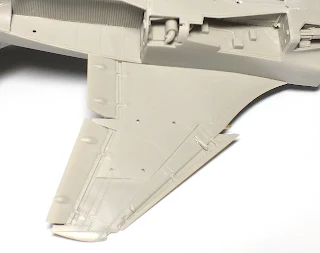
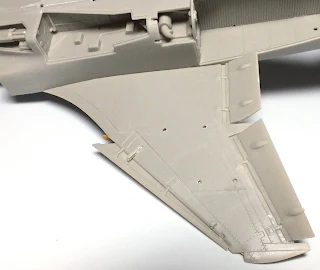
The tail unit and stabilisers were also added and
that was the major construction for the fuselage finished. The whole process
went a lot better than I thought it would and the minimum use of filler is a
real testament to the quality of the KittyHawk parts.
The last job on the construction front was to add the
nose section to the main fuselage and again I had a concern about whether or
not there would be the need for filler. As it turned out a very small amount of
filler was needed on the join, but this was a very small amount and easily
cleaned up with a piece of kitchen towel dipped in Mr Model Colour thinners
negating the need to do any sanding.
As can be seen in the above photographs this is an
excellent model and Kittyhawk should be congratulated on capturing the lines
and details of the Jaguar.
With all of the major construction out of the way the
model was washed in warm soapy water and put aside to dry before the painting
process starts, more about that in the next part....
Ethelian
Thanks to Kittyhawk for this review kit.
The kit is on sale at many hobby outlets - Pacific Coast Models has
it in the US and that Models for Sale has
it in Great Britain


